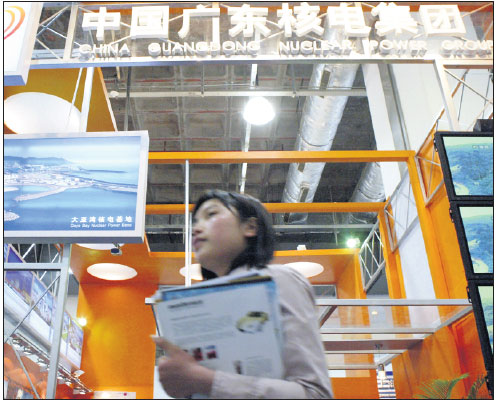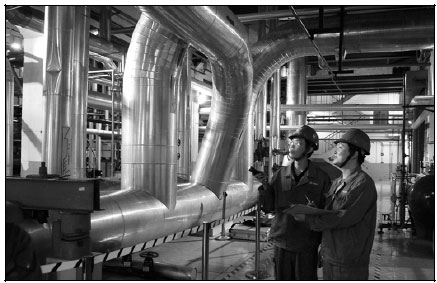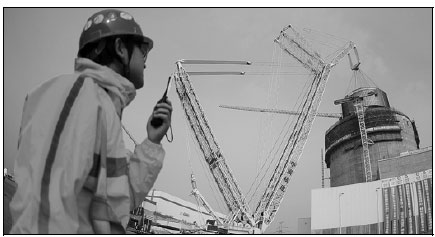China seeks strength beyond size
Updated: 2016-01-25 08:38
By Lyu Chang(China Daily USA)
|
|||||||||
Export of indigenous technologies and 10% share in domestic energy mix are future goals
Last year's big-ticket developments in China's nuclear power industry signify two key themes: the country's inexorable shift towards clean energy, in line with its commitment to be a responsible, climate-conscious economic giant, and its determination to be a leading global nuclear player in the decades to come.
As many as six nuclear reactors went online in 2015. The authorities concerned gave permits for the construction of eight more domestic reactors.
As for exports of nuclear technology, in November the country signed a $6-billion deal with Argentina to build a nuclear plant, the South American country's fourth. In United Kingdom, three nuclear power plants are likely to be built with possible Chinese nuclear technologies.
Last week China signed an agreement with Saudi Arabia to develop home-grown fourth-generation nuclear technology in the Middle East country.
But what helps China to stand out from the nuclear crowd is its stress on innovation, safety and popularization of its technologies, experts said.
Nuclear power is firmly etched into China's 13th Five-Year Plan (2016-20). According to the National Energy Administration, China's 28 nuclear reactors in operation have an installed capacity of about 25.5 gigawatts. The nuclear plants now under construction and those approved for construction would collectively generate an additional 30 gW in future.
Xu Yuming, deputy director of the China Nuclear Energy Association, said the current program would see the country emerging as the largest market for nuclear power plants. But, the priority is safe development of nuclear power and increase in the percentage of homegrown nuclear technology in the global market.
"Speed (of executing nuclear power projects) is not the goal. We should put safety above everything, and improve our ability to innovate and develop our own technologies for use domestically, while at the same time paving the way for their export, as per the new five-year plan," Xu said.
The safety-first principle became paramount after China suspended approvals for new reactors in 2011 in the wake of the Fukushima nuclear crisis in Japan, and went in for a review of safety standards at existing nuclear facilities.
In March last year, the government okayed construction of units 5 and 6 of Hongyan River nuclear power plant in northeastern Liaoning province, the first such project to receive approvals in four years.
From then, China started to ramp up electricity generation at its nuclear power plants, which gained currency as clean, abundant sources of energy with potential to fuel a high-growth economy.
Starting from May 2015, the government issued construction permits to units 5 and 6 of Fuqing nuclear power plant in southeastern Fujian province, units 3 and 4 of Fangchenggang nuclear project in Guangxi Zhuang autonomous region, and units 5 and 6 of Tianwan nuclear power plant in eastern Jiangsu province.
Experts said China's pledge to the international community that it will reduce carbon emissions and generate 20 percent of its electricity from clean energy sources by 2030, will push the country to use more nuclear power in the coming decades.
Xu said China, the world's largest energy consumer, is likely to add five or six nuclear reactors every year from 2016 to 2030, according to estimates in the draft 13th Five-Year Plan (2016-20).
"By then, nuclear power will account for 8 to 10 percent of the total energy mix," he said. Its current share is about 2 percent.
China is planning to have at least 110 nuclear reactors running by 2030. That would make it one of the largest nuclear energy users in the world.
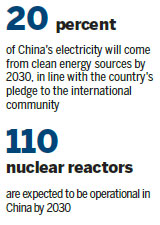
China also aspires to be a strong nuclear player. Hence, it is seeking to develop indigenous reactor technologies. Its three nuclear power companies are working to adapt the third-generation nuclear technology to the domestic market, so as to meet future energy needs.
The first unit of Hualong One nuclear power plant already runs on homegrown third-generation technology developed jointly by China National Nuclear Corp and China General Nuclear Power Group. Some 85 percent of such reactors can be made domestically, with a design life of 60 years.
"It is clear localization will play an increasingly important role. Domestic use of indigenous technology is a prerequisite for its export," said Yu Peigen, deputy general manager of CNNC. "If the design, software and even the fuel cannot be made domestically, how could we export our technology?"
Nestor, a Chinese-built software to design nuclear reactors, was tailor-made for Hualong One, to increase efficiency and quality of the plant construction and engineering, he said.
Nestor, he said, is analogous to the iOS operating system that powers iPhones, and is key to the third-generation nuclear technology. The software is expected to give a fillip to efforts to export China's nuclear technology.
Both CGN and CNNC have their own supply chains. So, their versions of Hualong One will differ but only slightly as the reactor design is standardized, which means 28 technical features remain the same.
CNNC is also developing a fast-neutron reactor, which belongs to the fourth-generation nuclear technology. This would enable China to depend less on imported supplies of uranium in future.
The State-backed company was behind China's first fast-neutron reactor, the China Experimental Fast Reactor, in 2011, whose operations reached full capacity in 2014.
The pool-type fast-neutron reactor has a thermal capacity of 65 mW and can produce 20 mW of electricity.
Meanwhile, the Shanghai Nuclear Engineering Research and Design Institute designed CAP1400, another third-generation nuclear reactor technology, based on the AP1000 reactor technology developed by the United States-based Westinghouse Electric Co LLC. China has promoted CAP1400 both domestically and abroad.
Zheng Mingguang, head of SNERDI, has said earlier construction of the pilot project of Shidaowan power plant in Shandong province, which will use the CAP1400 technology, is likely to start this year. There is high chance for the technology to be also used in South Africa's new-generation nuclear power stations.
"We have an edge over our competitors in terms of cost, reliability and security. Our technology incorporates both imported aspects and latest homegrown advances," he said.
lvchang@chinadaily.com.cn
|
A woman passes by the China Guangdong Nuclear Power Group pavilion in a recent nuclear power equipment expo in Shanghai. Provided To China Daily |
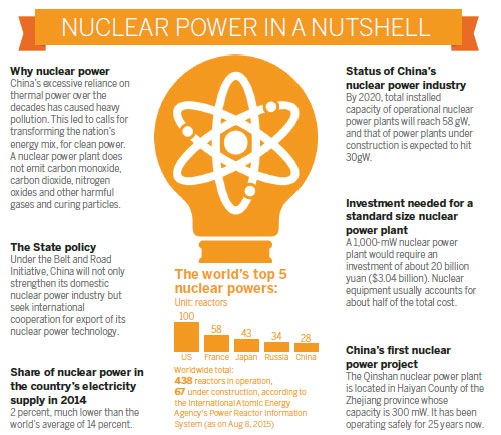
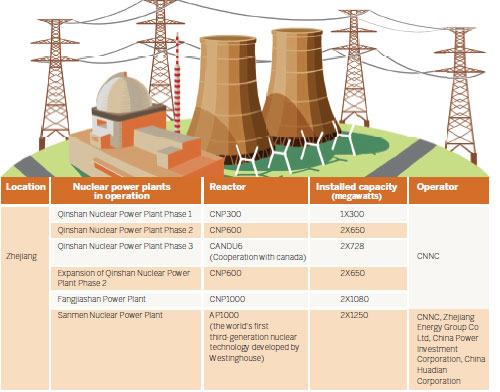
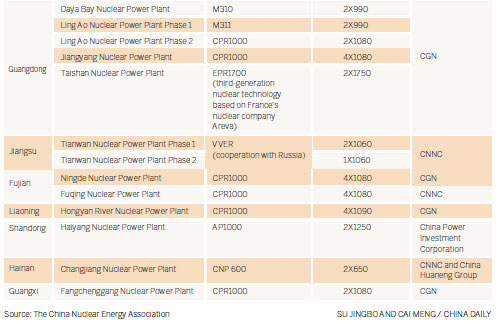
|
Technicians inspect the operation of Qinshan Nuclear Power Plant in Zhejiang province.Provided To China Daily |
|
A worker talks to a crane operator with a walky-talky at a nuclear power plant construction site in Shandong province.Provided To China Daily |
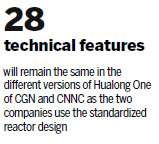
(China Daily USA 01/25/2016 page13)
- Netizen backlash 'ugly' Spring Festival Gala mascot
- China builds Mongolian language corpus
- China's urban unemployment rate steady at 4.05 pct
- German ecologist helps relieve poverty in Sichuan
- 'Unhurried' Guizhou village makes NY Times list of places to visit
- Railway police nab 40,315 fugitives in 2015
- 2 Chinese nationals killed, 1 injured in suspected bomb attack in Laos
- New York, Washington clean up after fatal blizzard
- 'Plane wreckage' found in Thailand fuels talk of missing Malaysian jet
- Washington shuts down govt, NY rebounds after blizzard
- 7 policemen, 3 civilians killed in Egypt's Giza blast
- Former US Marine held in Iran arrives home after swap

 Storm grips New York after dumping 2 feet of snow on Washington
Storm grips New York after dumping 2 feet of snow on Washington
 Art exhibitions in 2016 worth seeing
Art exhibitions in 2016 worth seeing
 Winter flexes its muscles as cold snap makes its way
Winter flexes its muscles as cold snap makes its way
 Snow blankets Washington D.C. in potentially record-breaking storm
Snow blankets Washington D.C. in potentially record-breaking storm
 Bright Temple of Heaven shines in winter
Bright Temple of Heaven shines in winter
 Netizen backlash 'ugly' Spring Festival Gala mascot
Netizen backlash 'ugly' Spring Festival Gala mascot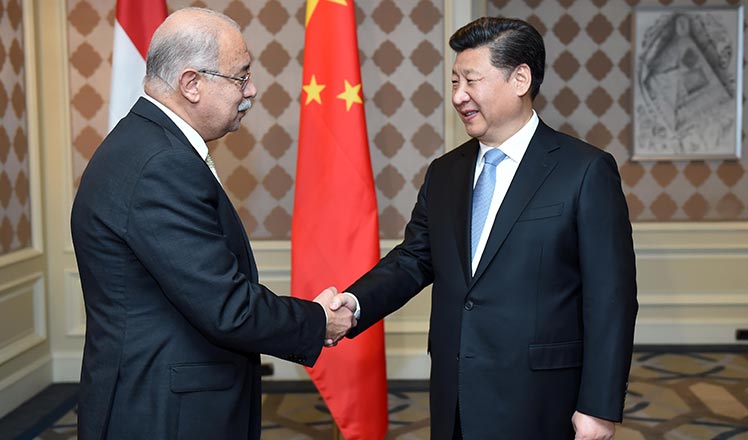
 Egyptian welcome for Chinese President Xi Jinping
Egyptian welcome for Chinese President Xi Jinping
 Robots reads China Daily to stay up to date with news in Davos
Robots reads China Daily to stay up to date with news in Davos
Most Viewed
Editor's Picks

|

|

|

|

|

|
Today's Top News
National Art Museum showing 400 puppets in new exhibition
Finest Chinese porcelains expected to fetch over $28 million
Monkey portraits by Chinese ink painting masters
Beijing's movie fans in for new experience
Obama to deliver final State of the Union speech
Shooting rampage at US social services agency leaves 14 dead
Chinese bargain hunters are changing the retail game
Chinese president arrives in Turkey for G20 summit
US Weekly

|

|
